
Catalog excerpts

ArcelorMittal Europe Long Products
Open the catalog to page 1
Trademarks: ArcelorMittal is the owner of the following trademark applications or registered trademarks: “Freefrom” & “Solam”. Photography copyrights: ArcelorMittal Image Library; Goodyear Dunlop Tires Operations EMEA; La robe à l'eau; Shutterstock - ssuaphotos; Siemens Wind Power; © Philippe Stroppa; © Studio Pons; Air liquide; Sidergas; Italfil; Roosevelt de Paula Almado; Siegenia-Aubi; wide.lu.; courtesy of Hendrickson Commercial Vehicle Systems Europe; courtesy of FLT KRASNIK – PBF; Fotolia; Gyusko-Photo / Shutterstock.com. Care has been taken to ensure that the information in this...
Open the catalog to page 3
Dear Customer, ArcelorMittal Europe has a long and rich tradition of producing bars and wire rod in its locations in Germany, France, Spain, Poland, Bosnia Herzegovina and Morocco. These plants are at the forefront of technical innovation and provide best-in-class customer service. They offer a wide spectrum of wire rod as well as SBQ and forging In recent years, our European plants have made major investments in state-of-the-art in coil production line in Zenica and a new vacuum degassing station. Furthermore, the wire rod rolling mills of Sosnowiec, Hamburg and Veriña are upgraded. and...
Open the catalog to page 4
Mechanical engineering Yield strength is the essential property of the elastic behaviour of the spring as it allows the part formed with these grades to return to its original shape after significant bending or twisting. The principal alloying elements used to achieve high yield strength are silicon, manganese, chromium and vanadium. Product development Springs are produced from medium or high carbon steels with a very high yield strength obtained by heat treatment after processing. Production units Quality range Key properties • Grade analysis: Si and Cr • Steel cleanliness/superclean •...
Open the catalog to page 5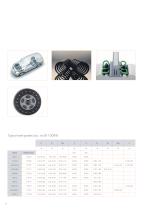
Typical steel grades (acc. to EN 10089) C
Open the catalog to page 6
Mechanical engineering High fatigue loads require surface quality and low inclusion content. Two metallurgical treatments are available to achieve this. Aluminium killed steel follows a clean metallurgical process to obtain a very low oxygen content. Sillicon killed steel produces grades with good deformability inclusions. The sizes of such inclusions are reduced during the rolling process. Product development Steel production requires expertise and strong process control: to achieve high performance, the heat treatment has to be very homogeneous throughout the part. Grade and structure...
Open the catalog to page 7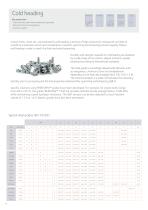
Cold heading Mechanical engineering Key properties •Cold ductility and final mechanical properties •Microstructure homogeneity •Surface quality Screws, bolts, rivets, etc. are produced by cold heading: a process of high productivity using punch and dies to transform a steel wire rod at room temperature. A specific quenching and tempering process regularly follows cold heading in order to reach the final mechanical properties. Ductility and strength required for cold heading are obtained by a wide range of low carbon, alloyed and boron grades produced according to international standards. The...
Open the catalog to page 8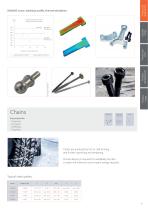
Products & applications 20MnB5 screw: hardness profile, thermal simulation Hardness profile of a bolt at 10 back from end to thread Quality range Production units Product development Product range Mechanical engineering Key properties •Toughness •Elongation •Weldability •Toughness Chains are produced by hot or cold forming and further quenching and tempering. Precise alloying is required for weldability but also to reach the minimum notch impact energy required. Typical steel grades Name
Open the catalog to page 9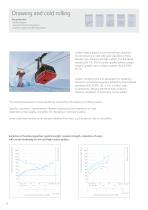
Drawing and cold rolling Mechanical engineering Key properties •Grade analysis •Microstructure homogeneity •Surface quality and descaling ability Carbon steel grades for wire rod and bars destined to cold drawing or cold rolling are classified in three families: low, medium and high carbon. The European standard EN 16120 for carbon grades defines a large range of grades with a carbon content from 0.03% to 1%. Carbon content is the first parameter for obtaining the final mechanical properties defined by international standards (EN, ASTM, JIS,…). For a wider range of properties, alloying elements...
Open the catalog to page 10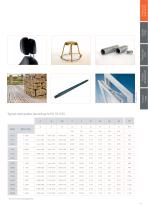
Products & applications Quality range Production units Product development Product range Typical steel grades (according to EN 16120) C
Open the catalog to page 11
Mechanical engineering Quenched and tempered steels, case hardening steels, micro-alloyed steels, bainitic steels Key properties •Grade analysis for final mechanical properties along with quenchability •Cleanliness in case of fatigue loads •Surface quality Carbon and Carbon Manganese Steels Carbon Steel grades are the most common steels used for forging applications. Low carbon steels (carbon between 0.05 to 0.25%) are the easiest to cold form due to their soft and ductile nature. Medium carbon steels (carbon between 0.26 and 0.59%) are typically used in medium and large parts forgings. High...
Open the catalog to page 12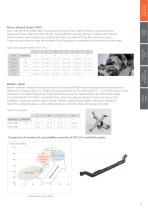
Products & applications Micro-alloyed steel grades allow the production of parts with higher strength, obtained without subsequent heat-treatment after forging. Typical additions include niobium, vanadium and titanium, which increases yield strength by precipitation hardening, while offering finer grain structures. These two outcomes increase the strength of the forged parts compared to conventional carbon steels. Quality range Bainitic steels Bainitic steels are designed for applications that require both high mechanical properties and process cost reductions, compared with Q+T grades. Very...
Open the catalog to page 13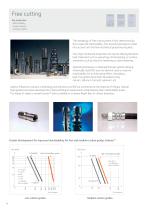
Free cutting Mechanical engineering Key properties •Machinability •Grade analysis •Surface quality The metallurgy of free cutting steels is first determined by their expected machinability. The second parameters to take into account are the final mechanical properties required. Very high mechanical properties can require alloying elements, heat treatment such as quenching and tempering, or surface treatment such as inductive hardening or case hardening. Machining behaviour is obtained through specific alloying. Historically, lead (Pb) was the element used to improve machinability for its...
Open the catalog to page 14All ARCELORMITTAL Long catalogs and technical brochures
-
Long Products
180 Pages
-
Slim-Floor
40 Pages
-
ACB® and Angelina® beams
64 Pages
-
Bridges With rolled sections
52 Pages
-
Stainless steel in construction
68 Pages
-
Arval Sunstyl
16 Pages
-
Pflaum & Söhne Bausysteme GmbH
72 Pages
-
Arval Colorissime
10 Pages
-
Steel Sheet Piling
56 Pages
-
Beam Finishing
8 Pages
-
ACB - Cellular Beams
48 Pages
-
RESIDENTIAL BUILDINGS
68 Pages
-
Angelina TM beams
38 Pages
-
Safety Barriers
12 Pages
-
Pfl aum & Söhne Bausysteme GmbH
72 Pages
-
Aluzinc® in Building
8 Pages
-
Colorissime
10 Pages
-
Form Tie Bars
2 Pages
-
ExpandedMetal
24 Pages
-
CARRIL / RAIL
28 Pages
-
AMCRPS
52 Pages
-
Sections and Merchant Bars
244 Pages
-
arival system by arcelormittal
80 Pages
-
ArcelorMittal Piling Handbook
368 Pages
-
Sunstyl
16 Pages
Archived catalogs
-
Material Selection Guide
23 Pages
-
Floor systems guide
96 Pages










































